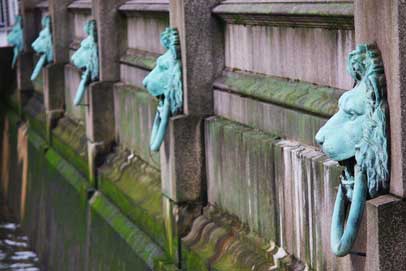Guide
Below you'll find a guide to all of the stops on this tour. Follow the numbered links to see where they are located on the map. Clicking the numbered link on the map will then return you to the relevant place in this guide.
If you want some coffee stop recommendations, I can vouch for Curious Yellow Kafé (on the cat's ear in Hoxton), Holy Shot (Bethnal Green Road, opposite Lady Dinah's), and Press (on Fleet Street just after Chancery Lane). Shoreditch has many excellent cafes and eateries - if you have any on the route worth mentioning here please let me know.
Public toilets - just off the route is the cab-driver's toilets on the NE corner of Lincoln's Inn Fields. In addition, Blackfriars Station has toilets and is not too far off the route as you cross Fleet Street. Again, let me know if you know of any others open at this time.
Remember to pause and then resume your ride if you do make a diversion, in order to preserve the cat shape!
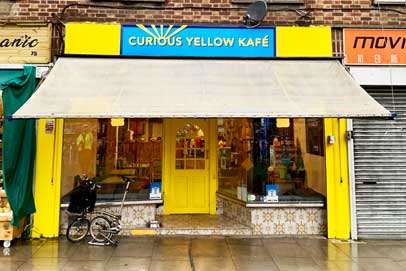

The South Bank Lion is a stone sculpture by William Frederick Woodington from 1837 which stands proudly at the Southeast corner of Westminster Bridge.
It’s made of Coade stone - a ceramic predominately made of clay which is fired in a kiln for several days. The stone is very weather-resistant, hence its features still look very sharp today.
This lion was one of three lions that were commissioned for the Lion Brewery Company, est. 1836, and situated where the Royal Festival Hall stands today. The lion stood proudly atop the brewery parapet. The brewery was damaged by fire and closed in 1931. King George VI ordered that the lion be preserved, along with its surviving sibling lion which stood over one of the brewery gates.
Between 1951 and 1966 the South Bank Lion was painted red as a symbol of British Rail and situated outside Waterloo station. It was removed from the station in 1966 in order for the station to be extended, and moved to Westminster Bridge.
The sibling lion can be found at Twickenham stadium - it was painted in gold leaf prior to the 1991 Rugby World Cup.
In 2018 a small brewery start-up adopted the brand, and it’s possible to buy Lion Brewery beer today.
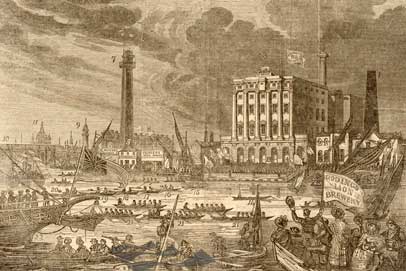
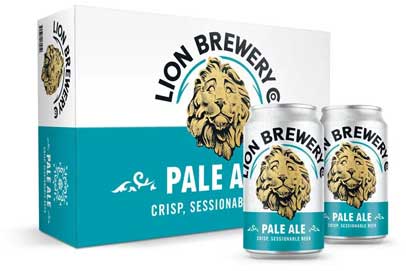
Partially hidden by the railings in front of parliament, this statue of one of the most controversial figures from Britain’s history has a handsome lion at its base.
Cromwell led armies against King Charles I in the English Civil War. Charles I was executed in January 1649. Cromwell then ruled Britain as Lord Protector from 1653 until his death by natural causes in 1658. He was buried with great ceremony, with an elaborate funeral at Westminster Abbey.
However, three years is a long time in politics, and in January 1661 his body was exhumed, taken to Tyburn and hanged, then thrown in a pit and the head cut off.
The head eventually made its way to its present location, under the floor of a Cambridge college, in 1960. We’ll visit a possible location for his body later during this ride.
If you look over the road in the direction Cromwell is facing, you can see a lead bust of Charles I looking back from over a doorway at St Margaret’s Church, next to Westminster Abbey.
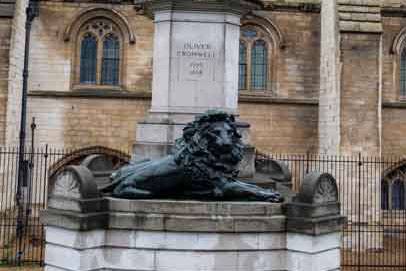
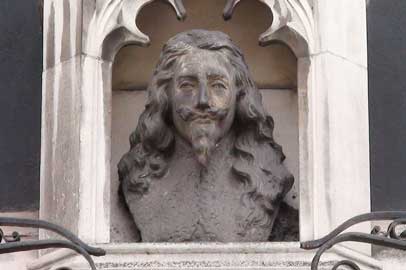
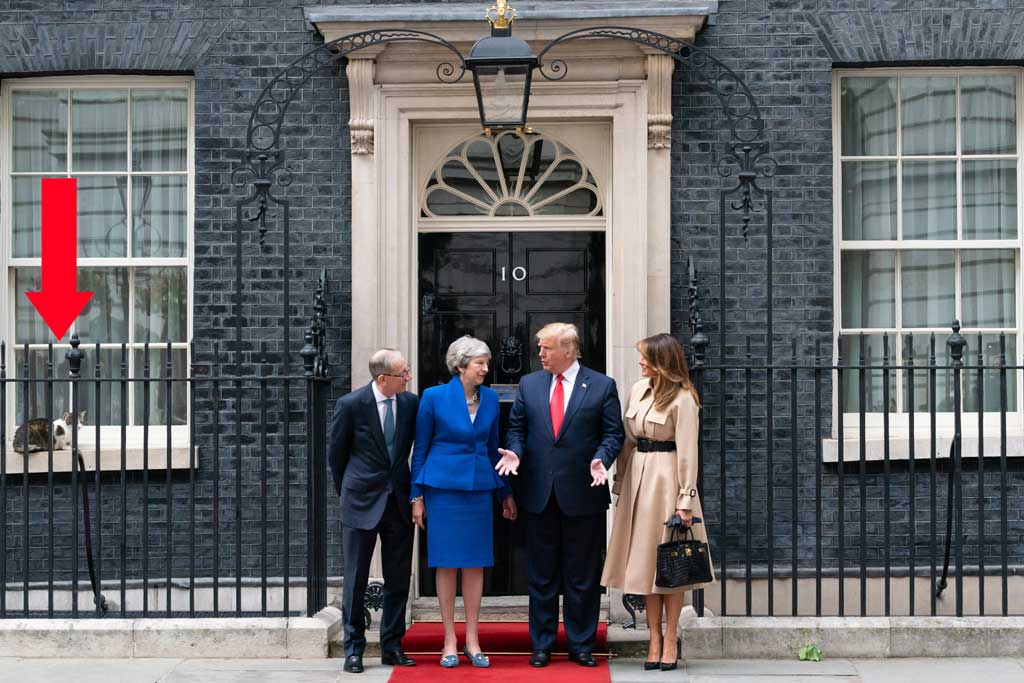
The Chief Mouser to the Cabinet Office is the title of the official resident cat of the Prime Minister of the United Kingdom at 10 Downing Street.
There has been a resident cat in the English government employed as a mouser and pet since the 1500s, although modern records date only to the 1920s. Though other cats have served Downing Street, the first one to be given the official title of Chief Mouser by HM Government is Larry in 2011, who is still in office today.
Humphrey was employed at 10 Downing Street from 1989 to 1997. He was frequently seen in photographs of number 10, and was popular with the media. Humphrey was said to be of considerably better value than the Cabinet’s professional pest controller, who charged £4,000 a year and is reported to have never caught a mouse.
| Name | Began tenure | Ended tenure | Prime Minister(s) |
|---|---|---|---|
| Larry | 2011 | current | David Cameron, Theresa May, Boris Johnson |
| Freya | 2012 | 2014 | David Cameron |
| Sybil | 2007 | 2009 | Gordon Brown |
| Humphrey | 1989 | 1997 | Margaret Thatcher, John Major, Tony Blair |
| Wilberforce | 1973 | 1986 | Edward Heath, Harold Wilson, Jim Callaghan, Margaret Thatcher |
| Peta | 1964 | c. 1976 | Alec Douglas-Home, Harold Wilson, Edward Heath |
| Peter III | 1947 | 1964 | Clement Attlee, Winston Churchill, Anthony Eden, Harold Macmillan, Alec Douglas-Home |
| Peter II | 1946 | 1947 | Clement Attlee |
| Nelson | 1940s | Winston Churchill | |
| Munich Mouser | 1937–40 | 1943 | Neville Chamberlain, Winston Churchill |
| Peter | 1929 | 1946 | Stanley Baldwin, Ramsay MacDonald, Neville Chamberlain, Winston Churchill, Clement Attlee |
| Rufus of England (popularly nicknamed "Treasury Bill") | 1924 | c. 1930 | Ramsay MacDonald |
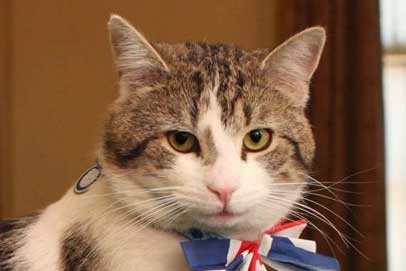
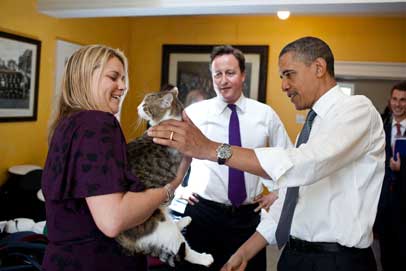
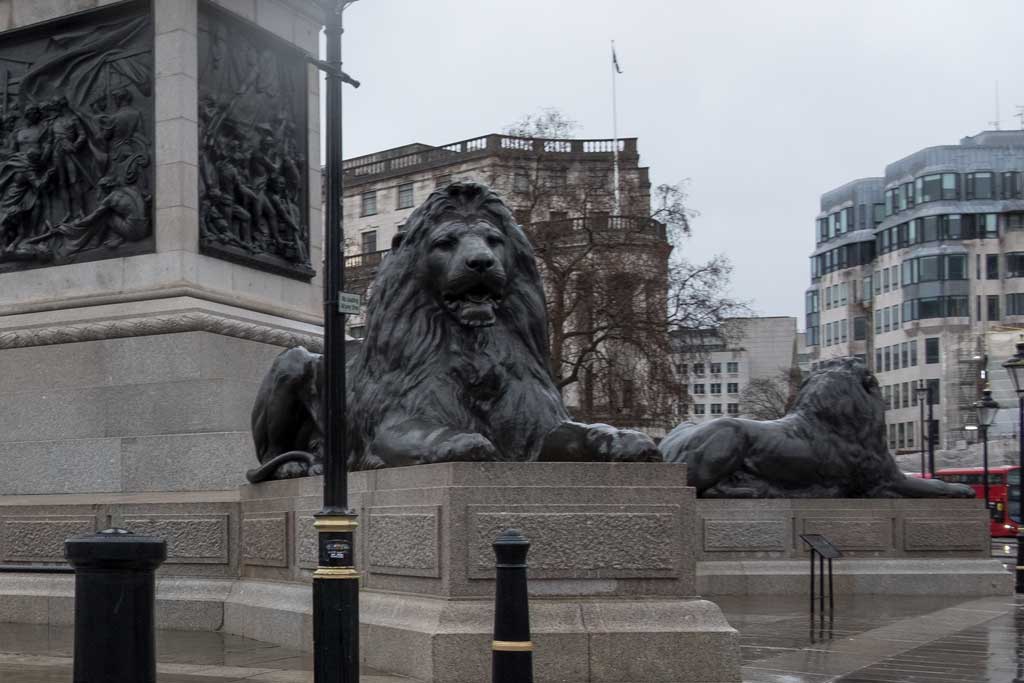
The four monumental bronze lions in Trafalgar Square were added in 1867, guarding Nelson’s column which had been erected 24 years earlier. Each lion is 22 feet long.
The first sculptor to be commissioned for the work produced four stone lions. At 8 feet in length, these were deemed not grand enough and were removed. These excellently sculpted lions can now be found in Saltaire, near Bradford.
Bizarrely, the commission for the sculptures was then given to a painter, Sir Edwin Landseer. He took nine years to complete the project. The first four years were spent visiting London zoo and making sketches.
He asked for a lion that had died at the zoo to be brought to his studio. He took so long to complete sketches that it began to decompose and some parts had to be improvised. Hence the statues have paws that resemble cats more than lions.
These are the second-largest lion sculptures in the UK, the largest being the Maiwand Lion in Reading.
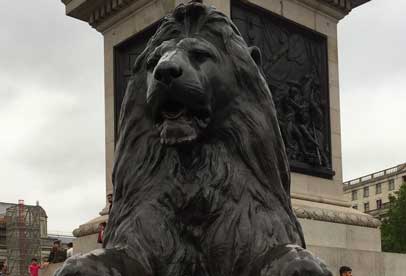
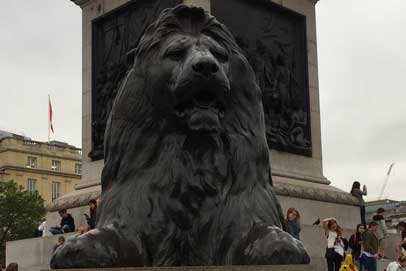
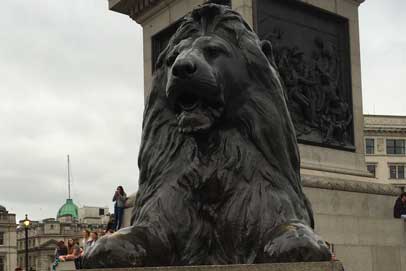
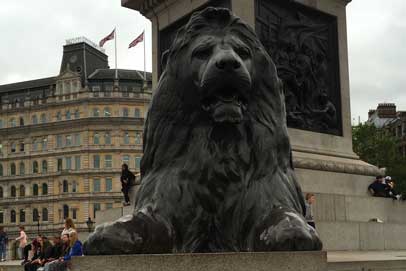
Whilst we’re at Trafalgar Square, for bonus cat points, take a quick peek at the door handles for Tourism Malaysia, at Malaysia House, 57 Trafalgar Square which is situated opposite, on the corner of The Mall.
In the film The Living Daylights, James Bond (Timothy Dalton) briefly visits his office at MI6 – which he accesses through this doorway with the cat door handles at Malaysia House.
Malaysia is home to the largest black panther population in the world but the animal is facing a serious threat due to habitat loss and poaching, which are also the main threats to the region's other big cats ― tigers and clouded leopards.
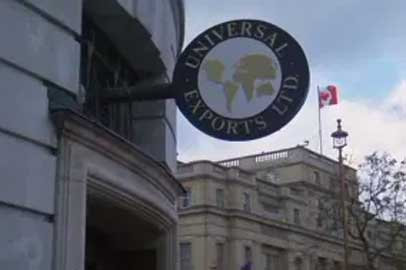
As you make your way up Wardour Street, be sure to pause at number 7 Wardour Street, a Chinese Medicine shop.
In 1886 it was occupied by Don José Joaquin Carreras Ferrer, who established the Carreras Tobacco Company here. The trademark of the company was a black cat, which supposedly was based on the domestic cat that sat in this shop. Whilst there are no cats to be seen at this location today, we will see the Carreras black cat later on in this ride.
Whilst we are on the topic of shop cats, it's worth mentioning Binks. In 1921, as a kitten, he strolled into Bates Hatters on nearby Jermyn Street and decided to make the shop his home. The staff named him Binks and he charmed everyone he met. When he died the staff couldn’t bear to say goodbye, so they had him stuffed. To this day Binks presides over the shop from his vantage point under a glass dome, wearing a top hat and with a cigar in his mouth. Sadly he's not visible from the street, so isn't included on our itinerary.

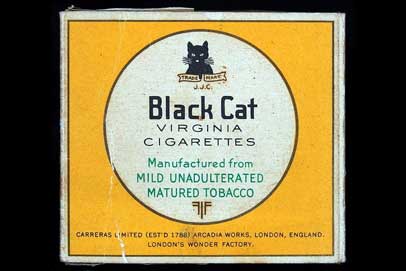
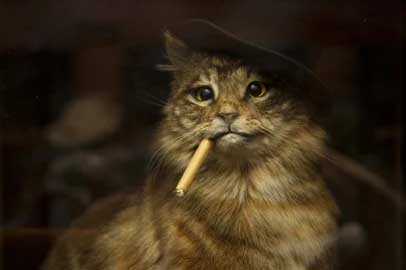
Half-way along Gerrard Street are two stone lions. These were unveiled by the Duke of Gloucester in 1985 (during the quatercentenary year of the City of Westminster) at the formal opening of Gerrard Street China Town.
There are several more pairs of guardian lions nearby.
Chinese or Imperial guardian lions are a traditional Chinese architectural ornament. Typically made of stone, they are also known as stone lions or shishi (石獅).
The concept, which originated and became popular in Chinese Buddhism, features a pair of highly stylized lions—often one male with a ball and one female with a cub—which were thought to protect the building from harmful spiritual influences and harmful people that might be a threat.
Used in imperial Chinese palaces and tombs, the lions subsequently spread to other parts of Asia including Japan, Korea, Tibet, Thailand, Burma, Vietnam, Sri Lanka, Nepal, Cambodia, Laos, Taiwan, and Malaysia.
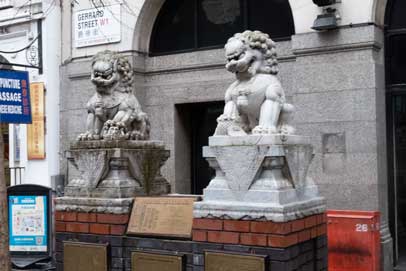
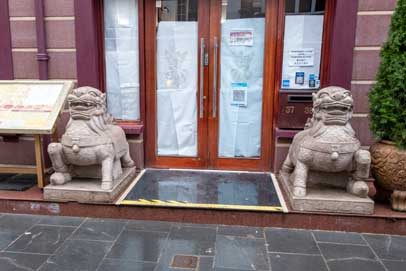
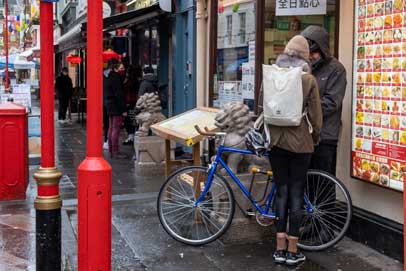
With a 4-star rating on Tripadvisor, this pub is run by Greene King dates back to 1769.
This pub is more recently known for being the location where serial killer Dennis Nilsen ensnared at least four of his victims. All of whom were later abused, butchered, broiled on the hob, and flushed down the toilet back at Dennis' flat. He was eventually caught by a Dyno-Rod employee, who discovered the human remains blocking the drains when responding to a plumbing incident. Nilson was imprisoned for life and died in 2018.

Glance in the window of 68 Dean Street as you pass this well-kept Georgian end-of-terrace property, and if it hasn't been removed, you might catch a glimpse of Top Cat.
Top Cat is an American animated sitcom produced by Hanna-Barbera that first ran for 30 episodes during 1961 and 1962.
The central character, Top Cat (T.C.) is the leader of a gang of Manhattan alley cats living in Hoagy's Alley: Fancy-Fancy, Spook, Benny the Ball, Brain, and Choo-Choo.
Top Cat and his gang were inspired by the East Side Kids, humorous tough characters from a series of 1940s B movies, but their more immediate roots lay in The Phil Silvers Show which ran from 1955 to 59.
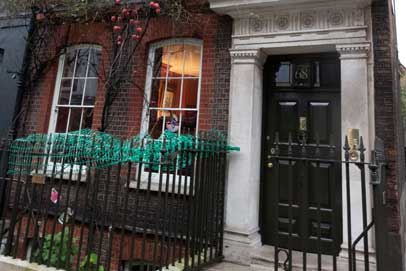

Several shops and restaurants in China Town have small beckoning cats made of porcelain or plastic in the window. These are Maneki-neko and originate in Japan.
They are thought to bring good luck. It may seem as if the Maneki-neko is waving rather than beckoning. This is due to the difference in gestures and body language recognized by some Westerners and the Japanese. The Japanese beckoning gesture is made by holding up the hand, palm down, and repeatedly folding the fingers down and back, thus the cat's appearance.
Maneki-neko can be found with either the right or left paw raised (and sometimes both). Some believe a statue with the left paw raised is said to get more customers, while the right paw raised is to get more money. Hence it is also said that the one with left paw is for business and the right is for home.
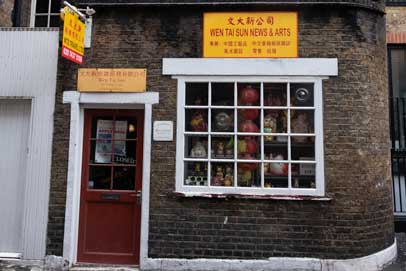
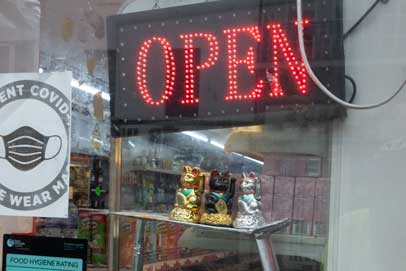
The hotel’s lobby has a 10ft bronze sculpture of a cat by Colombian figurative artist and sculptor Fernando Botero.
His signature style, known as “Boterismo”, depicts people and figures in large, exaggerated volume. In his words, "An artist is attracted to certain kinds of form without knowing why. You adopt a position intuitively; only later do you attempt to rationalize or even justify it."
The hotel is temporarily closed at time of writing, but you can view the sculpture through the windows facing onto Richmond Mews, or from the windows by the reception area.

According to the blurb on their website, Flying Tiger is a store for adventurers, artists, fun seekers and dreamers.
The first store called Tiger opened in Copenhagen in 1995, and everything in it cost 10 Danish kroner. The Danish word for a ten-kroner coin is pronounced tee’-yuh, which sounds just like the Danish word for tiger.
Look above the entrance and you'll see more felines carved in stone.
Fancy living here? There's a 3-bed flat at 105 Oxford Street currently on the market for £2.3m.
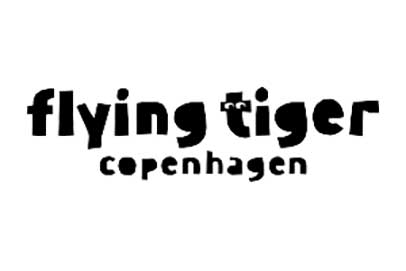
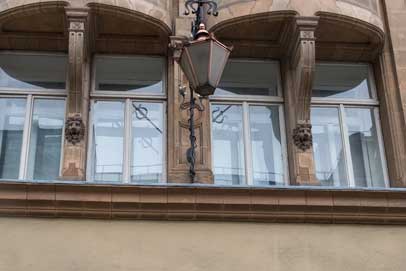
You want bonus cat points? Pass by Ilford House, 133-135 Oxford Street.
Here you’ll find a pair of bronze lion door handles adorning the original coffered timber doors on this fine Edwardian Baroque-style Grade II listed building, built in 1911, which is hidden in plain sight on a busy section of the street.
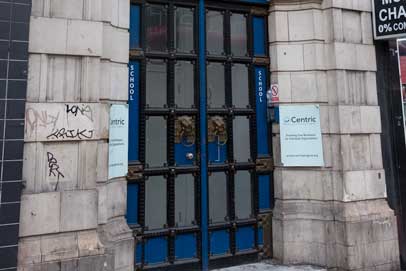
The Fitzrovia Mural can be found in Whitfield Gardens, set just a little way back from Tottenham Court Road, opposite Heals.
Commissioned by Camden Council in 1980, it depicts the life of the local community. It’s by Mick Jones and Simon Barber and took six months to complete. It has recently been restored. Somewhere in this mural is a cat. Can you find it?
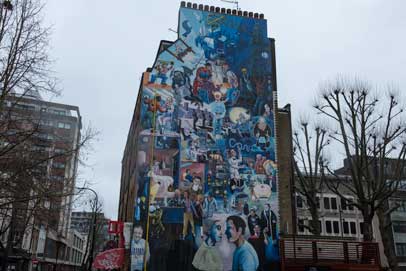
The Heal’s cat sits halfway up the stairs at the back of the store.
In the Twenties, this large bronze cat was just another item for sale, but the staff became very fond of the cat, fanned in part by a shop assistant (Dodie Smith, at the time a struggling actress, later to become author of 101 Dalmations) who said that wishes may be granted if you touched its paws.
One day the cat was sold for £40, but when owner Sir Ambrose Heal found out it had been sold, he wrote to the customer cancelling the sale and placed a card on the cat saying, “Heal’s Mascot. Not for Sale”. The cat has been there since.
If the store is shut, you may not be able to place your wish, but you can still read about the cat on the poster outside, just to the right of the main entrance.
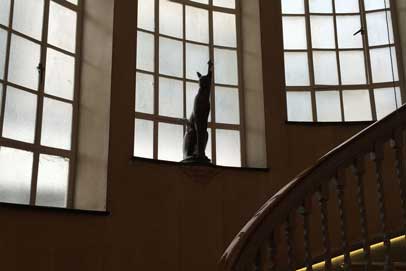
The former Carreras Cigarette Factory, sometimes called simply the ‘Black Cat Factory’, is a large art deco building dating from the 1920’s and is an example of Egyptian revival architecture.
The building was somewhat revolutionary. It was the first to use pre-stressed concrete and at the time was the largest reinforced concrete factory in the country. It was also the first to install air-conditioning and have a system for dust extraction.
It was designed by Marcus Evelyn Collins and Owen Hyman Collins. The extraordinary design was fuelled by one of the most exciting archaeological discoveries ever seen; Tutankhamun’s tomb in 1922. The discovery prompted a wave of Egypt-mania in fashion, architecture and design. Other examples include the famous Hoover building along the A40 as well as the former cinema on Essex Road.
The pillars along the front were supposedly inspired by the Egyptian Tomb of Panehsy.
Dominating the entrance to the building were two large bronze statues of cats, stylised versions of the Egyptian god Bastet. The image of a black cat was a branding device which Carreras used on cigarette packets. Note also the cat motifs all the way along the front near the top.
In 1959, Carreras merged with Rothmans and moved out. In the 60’s, the factory was converted to offices and the Egyptian stylings removed. These were added back, along with replicas of the cats, in 1996.
Today the converted office spaced is still used and is home to ASOS fashion brand along with the British Heart Foundation.
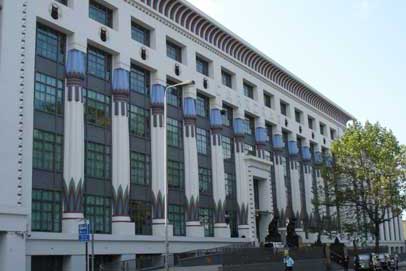
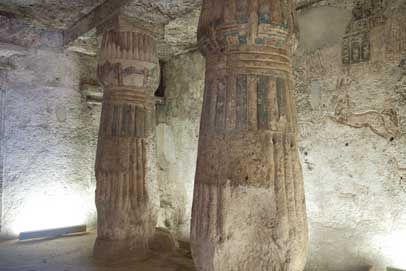
Installed in 1997, a bronze sculpture of Sam the cat honours local resident and nurse Patricia Penn (1914-1992)
Described as a ‘formidable lady’ — but very popular — Ms Penn had been very active in the area in the 1970s, campaigning to protect it from developers and to preserve historic buildings. Ms Penn was a cat lover and Sam was one of her pets.
Sam’s statue was stolen in August 2007, but in May 2009 a new Sam was unveiled.
To find Sam, enter the gardens and immediately turn left. Sam is nestled in the corner.
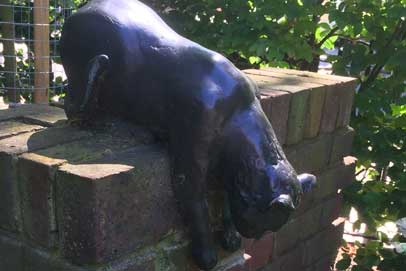
Sitting on a pedestal in the Alf Barrett playground is Humphry (currently in the far corner whilst renovation work is underway - Feb 22).
These words are from Carole Solway:
“MARCIA SOLWAY was my daughter, she made this sculpture of HUMPHRY. He was the resident cat for 18 years at the Mary Ward Centre in Queen Square WCI, where Marcia was a student of Sculpture. HUMPHRY was a ginger Tom, this area would of been his “hunting ground”. He was a champion mouser!
HUMPHRY was named after the founder of the Mary Ward Centre. The cat was cared for by RICHARD, who would feed him even when the centre was closed. When Richard died a wreath of flowers was placed around HUMPHRY’S neck, because Richard and Humphry were “best friends”.
Humphry was originally unveiled in Queen Square Garden WCI, but was resited into the children’s playground Old Gloucester St. WCI where he is much happier! The children love him, even drawing on him giving him “eyes and whiskers”. The playground is used by local children and children from Great Ormond St. hospital which is just around the corner.
MARCIA suffered with EPILEPSY and was a patient of the National Hospital Queen Square, she died aged 34 years August 1992, the same year as HUMPHRY. MARCIA lived in Rosebery Ave ECI, she was an ardent cat lover.”
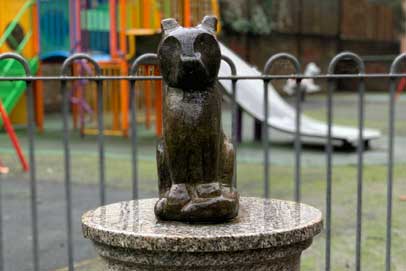
As you pass take a quick look in the entrance lobby of Nyx Hotels.
This 'lifestyle' hotel knows how to make a guest feel welcome.
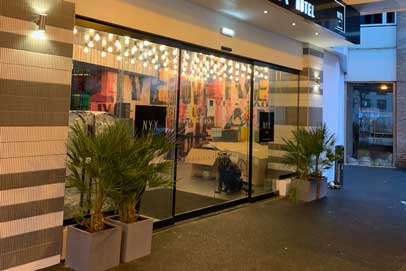
Red Lion Square was laid out between 1698 and 1700 by Dr Nicholas Barbon, and was named after the nearby Red Lion Inn in Holborn. Barbon was one of the major developers in the early history of London squares, who pursued profits ruthlessly and dishonestly.
He routinely ignored the law and often demolished buildings and built new houses without the permission of the owners. He forced through the development of Red Lion Square in his usual style, facing down fierce opposition from the lawyers of Gray's Inn, which led on one occasion to a physical fight between Barbon's men and the lawyers.
Most of the buildings around the square were replaced in the 19th and 20th centuries, but numbers 14 to 17 are houses originally built by Nicholas Barbon around 1686, which were re-fronted in the 19th century.
Number 17 was briefly the residence of poet and painter Dante Gabriel Rossetti, who founded the Pre-Raphaelite school of painting. Five years later, he recommended the rooms to his friends William Morris and Edward Burne-Jones, despite their dampness and decrepitude. It was here that Morris first tried his hand at furniture and textile design, producing the first of the medieval-style furnishings which gave rise to the Arts and Crafts movement.
In 1861 Morris, Burne-Jones and Rossetti set up a design business together at No. 8 Red Lion Square, to produce high- quality furniture and fittings using traditional craft methods. Their housekeeper, known as 'Red Lion Mary', did much of the sewing and tapestry, and also contributed to some of Morris's designs.
On the corner of Summit House is a plaque to John Harrison (1693-1776) who lived at number 12. He invented the marine chronometer, the first accurate nautical instrument to plot longitude.
Another 18th- century resident of the square, philanthropist and merchant Jonas Hanway (1712-1786) is reputed to have been the first habitual user of an umbrella in London. He teamed this with a sword, which by that time was a most unfashionable article of apparel!
The body of Oliver Cromwell (1599-1658) was popularly believed to have been buried where the square now stands. In 1660 when Charles II returned from exile, he took his revenge on all those who had supported the Parliamentary cause. The leading parliamentarians, Oliver Cromwell, John Bradshaw and Henry Ireton were all dead, but in 1661 Charles had their bodies dug up and given a trial for regicide. They were found guilty and sentenced to be hanged. The bodies of Cromwell and Ireton were kept overnight at the Red Lion Inn before being taken to Tyburn and hanged. One version of the story goes that the corpses were substituted for others, and Cromwell's body was in fact buried in Red Lion Square. Whatever the facts, the square is now said to be haunted by the men. Many claim to have seen the three, deep in conversation, walking diagonally across the square, only to vanish gradually as they pass the centre of the garden.
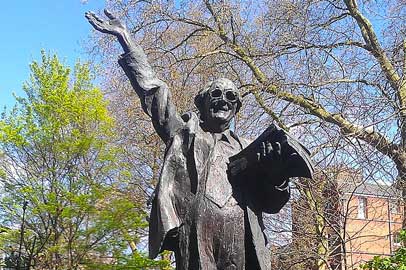
As you head down Clerkenwell Road, pull over briefly after the junction with Grays Inn Roads to admire the lions on the Gray's Inn Buildings.
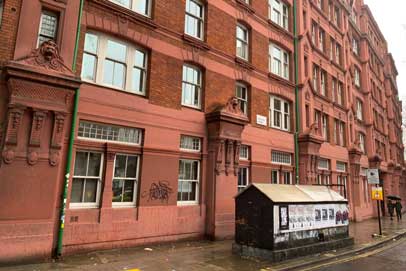
Look mum no hands! is an excellent cycle cafe - an easy-going space offering excellent food and drinks, a bike workshop, cycling-related exhibitions and events.
Normal-times (when the cafe is open) I would highly recommend stopping off here for refreshment, and who knows, maybe you’d like to purchase one of the caps, badges or face-masks by artist Bob Motown specially commissioned by lmnh! which features Bob the Cat. Orders can also be placed online.
Also worth a mention is London Bike Kitchen, situated on the CS1, a 5 minute ride away from here. London Bike Kitchen is a mechanic owned & operated open DIY workshop where you can work on your own bike instead of giving it to someone else. You can take classes, learn to do tasks on your own bike with support from others, as well as use the space and tools. I took a wheel-building class here seven years ago and have successfully built many sets of wheels since. What’s this got to do with cats? You can buy cat merchandise here too. I recommend the London Bike Kitten t-shirts.
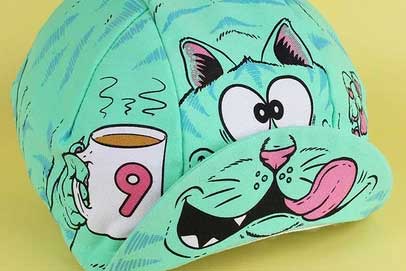
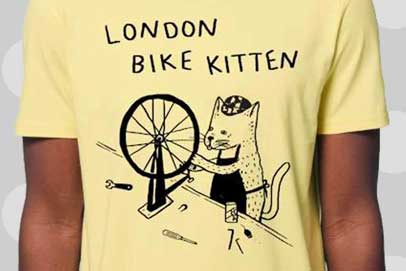
As you head down the cobbles of Shacklewell Street be sure to notice the tiger on the wall mural on your right.
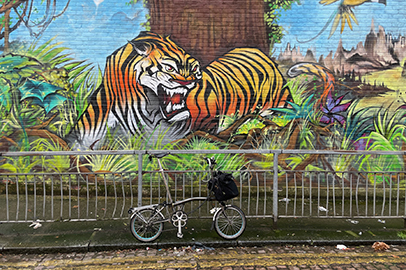
Lady Dinah’s was London’s first Cat Cafe.
It's a calm and quiet tea house situated on the busy Bethnal Green Road, and it’s home to around 13 rescue cats. Each cat has a bio on their website https://ladydinahs.com/pages/our-cats.
When the Cat Emporium is shut you can still get your cat-fix here, by admiring the cat art on the shop shutters.
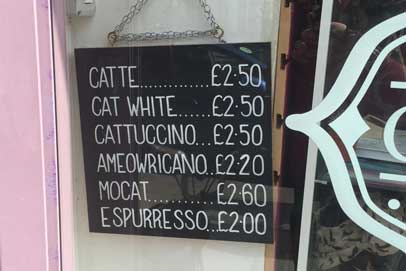
I’m not sure if it is the road name and its link with the cat in Alice In Wonderland, but the graffiti in Cheshire Street in London’s East End sometimes has a cat theme. Take five minutes to walk up and down the street to see if you can find one.

Kill the Cat is an award-winning craft beer bar and bottle shop for the 'beer curious'.
They've been shortlisted in the Independent Beer Retailer of the Year in this year's Drink Retailing Awards.
"WHAT THE HECK HAVE YOU GOT AGAINST CATS??!"
"The simple answer is, nothing! Kill The Cat is a different breed of craft beer bar and bottle shop – one that entices you to be more adventurous in your beer choices. So why Kill The Cat? Because it’s all about curiosity."
Phew!
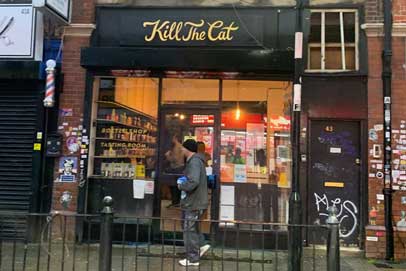
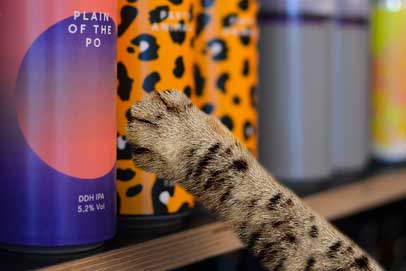
London's famous Southwark Cathedral is traditionally recognized for its architectural significance.
But in recent years the Gothic cathedral, which stands on the south bank of the River Thames, became known for another reason -- the presence of a stray cat, affectionately named Doorkins Magnificat, who made the building her home for 12 years before passing away on September 30 2020.
Before retiring in 2018, she had met the Queen, published a book, been immortalised in her own corbel, set up her own cat food bank supporting a local cat charity, set up her own range of merchandise, her own social media account – and entertained tens of thousands of visitors – some who come just for the pleasure of trying to spot her.
During her years spent at the church, Doorkins was a warm presence for congregants, new and returning alike. But in 2017, her health began to take a turn for the worse. Kidney problems, hearing loss, and blindness all befell her, and she eventually went to live with Paul Timms, the head verger, at his home. She suffered a stroke at the end of September and died in his arms.
To commemorate the beloved feline, Southwark held a memorial service under its Gothic arches and then laid Doorkins to rest in the churchyard. Due to COVID-19 restrictions, only 30 people were allowed to attend the ceremony, but it was simultaneously live streamed and is available to watch on YouTube. Since being held on October 28, 2020, there have been nearly 20,000 views of the service.
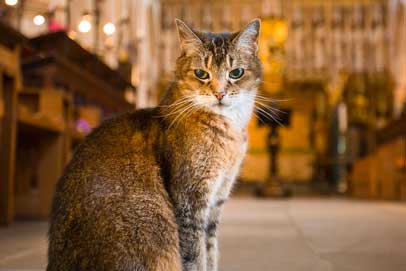
Richard Whittington (c. 1354–1423) lived locally. He was a merchant and politician, four-times mayor of London, member of parliament and sheriff of London. He was also the inspiration for the folk tale Dick Whittington and his Cat.
One of his earlier philanthropic acts was to pay for the rebuilding and extension of St Michael Paternoster Royal after a vacant plot of land was acquired.
On the south wall, a stained glass window depicts Dick Whittington with his cat. It looks great from inside, but is also clearly visible from outside, if the church is closed.
Sir Richard was buried in St Michael’s in 1422. His grave has since been lost. An attempt to find his grave in 1949 did uncover a mummified cat, but no Lord Mayor.
The church was first recorded in the 13th century. It was destroyed in the Great Fire of London in 1666. It was rebuilt, but severely damaged again during the blitz. It was restored again between 1966 and 1968.
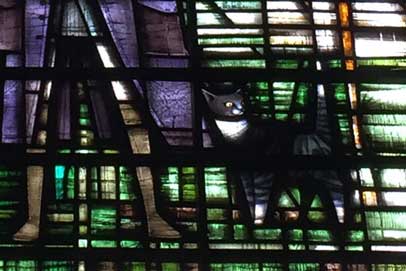
Whilst we are in the neighbourhood it’s worth passing St Mary Le Bow, famous for its bells.
The sound of the bells of St Mary's is prominent in the story of Dick Whittington and His Cat, in which the bells are credited with having persuaded him to turn back from Highgate and remain in London to become Lord Mayor.
In 2012 study showed that in the modern era, noise pollution means that the bells can only be heard as far as Shoreditch. According to legend, Dick Whittington heard the bells 4.5 miles away at the Highgate Archway. The studies found that it is credible that Whittington might have heard them on one of the infrequent days that the wind blows from the south.
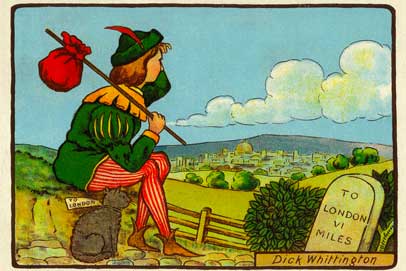
St Augustine’s church was first recorded in the 12th century. Like St Michael Paternoster Royal Church and much of the city, it was destroyed by the Great Fire of London in 1666 and rebuilt to the designs of Christopher Wren.
Faith, the church cat, gained fame after the air raid which destroyed St Augustine’s in 1941. Days before, Faith was seen moving her kitten, Panda, to a basement area. Despite being brought back several times, Faith insisted on returning Panda to her refuge.
On the morning after the air raid the rector searched through the ruins and eventually found Faith, surrounded by smouldering rubble and debris but still guarding the kitten in the spot she had selected three days earlier.
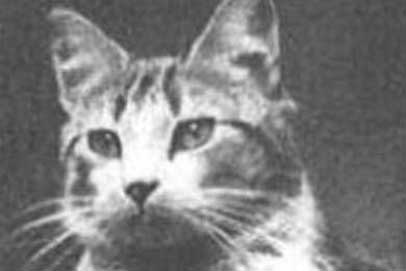
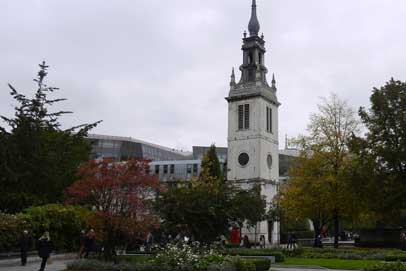
Hodge was one of the cats of author Dr Samuel Johnson (1709–1784).
A bronze statue of Hodge by Jon Buckley stands in the courtyard outside Dr Johnson’s House (now a museum) at 17 Gough Square. Hodge is depicted sitting atop a copy of Johnson’s famous dictionary with a pair of oyster shells at his feet, and an inscription underneath which reads “a very fine cat indeed”.
In James Boswell’s biography Life of Samuel Johnson, Boswell wrote, “I never shall forget the indulgence with which he treated Hodge, his cat”.
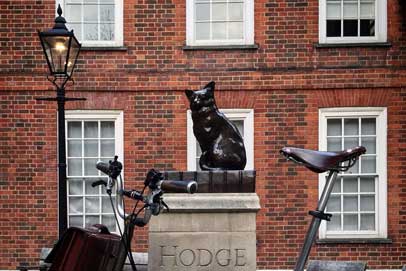
A quick diversion from the Strand takes us to the Seven Bells pub, tucked behind the Royal Courts of Justice, and home to the pub cat Clement Attlee.
This pub with a legal theme has had a succession of pub cats (in recent years Peabody, Ray Brown, and Tom Paine), who have worn a white ruff.
The pub survived the Great Fire of London, and had its 400th birthday in 2002.

The two topiary cats outside The Savoy hotel are in the shape of the hotel’s wooden scultpure, Kaspar the cat.
The Savoy’s famous black cat, Kaspar, was carved in 1927 by the designer Basil Ionides, from one single block of plane. His intended function was to act as the fourteenth guest in the private dining rooms when thirteen guests were present, and his creation was directly related to the unfortunate demise of a Savoy client over quarter of a century earlier.
In 1898, the diamond magnate Woolf Joel gave a dinner party at The Savoy before he departed to South Africa. One or two guests cancelled at the last minute and thirteen sat down at the table. There was discussion at dinner about the superstition of the number 13, and the host laughed off the superstitions including one where the earliest to leave the table would be destined to be the first to die. He offered to leave first to put his guests at ease. A few weeks later, however, Woolf was shot dead in his office in Johannesburg.
The management of the Savoy decreed that in future any table of thirteen would be joined by a member of staff as a fourteenth guest, and for the next twenty-five years a waiter would duly be roped in as necessity dictated.
This was not the most convenient of solutions, and hence the idea of the black cat. Since the 1920’s Kaspar is added to the table whenever a booking is made for thirteen. With a napkin around his neck, he sits silently at his place, and is served with each course in turn along with the rest of the guests.
When not working, he greatly enjoys sitting in state in the restaurant Kaspar’s or in the Front Hall, watching the world go by.
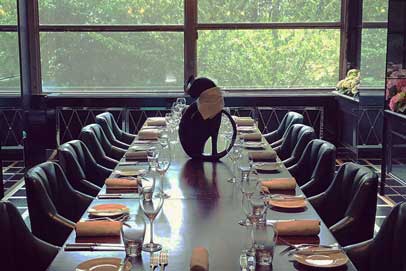
Cleopatra’s needle is one of a pair of ancient Egyptian obelisks originally located in Heliopolis around 1450 BC and moved via a treacherous and costly journey to London in 1877-1878.
It’s twin is in Central Park, New York. The popular name for this type of obelisk is in this case a misnomer, as it actually pre-dates Queen Cleopatra VII of Egypt by over 1,000 years.
Two large bronze Sphinxes lie on either side of the Needle. These are English Victorian versions, rather than Egyptian originals. Note the sphinxes are installed backwards - they appear to be looking at the obelisk, rather than guarding it. There are shrapnel holes and gouges on the right-hand sphinx from a bomb during a World War I air raid on 4 September 1917.
Also note the benches on the Embankment also have winged sphinxes on either side as their supports.
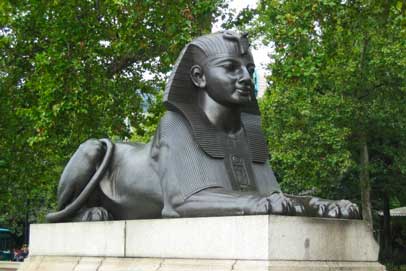
After passing underneath the Hungerford Bridge, find the opportunity to take a look at Thames-side of the river wall.
The mooring rings along this stretch are ornate and feature bronze lions. They were sculpted by Timothy Butler for Sir Joseph Bazalgette’s Victorian sewage works programme in 1868-70.
